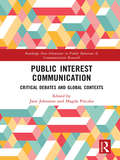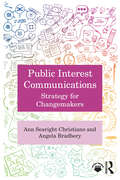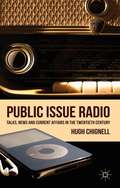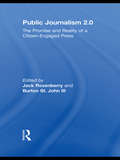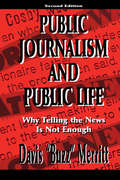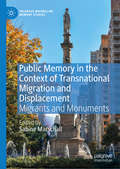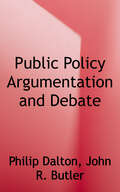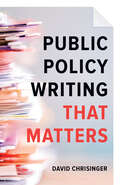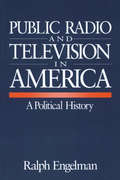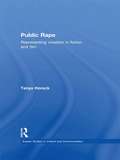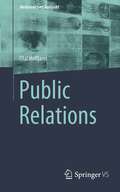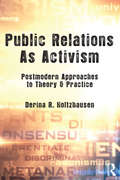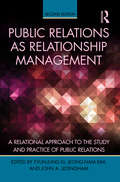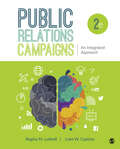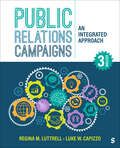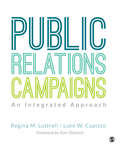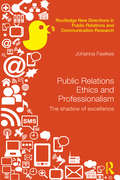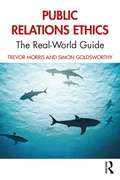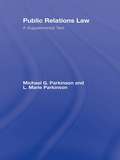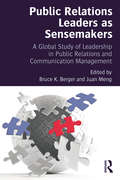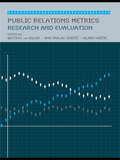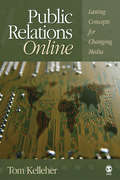- Table View
- List View
Public Interest Communication: Critical Debates and Global Contexts (Routledge New Directions In Public Relations And Communication Research Ser.)
by Jane Johnston Magda PieczkaCommunication has become the technology of public interest, demanding a re-examination of the key concept of public in both public relations and communication theory. This book defines a new concept of public interest communication, combining the conflict, negotiation and adaptation inherent in public interest, with a critical approach to communication management and public relations. Combining conceptual discussions about public theories of language with the tension between the public and private interests for public relations professionals, the book uses case studies to explore the negotiation of conflicting interests and the construction of the public interest within systems of governance at local, national and international levels. Public interest communication is identified within social and cultural contexts that resonate globally – health, community, media and the environment - each representing interest conflicts within the changing global environment. Addressing the forces of fragmentation, inequality and individualisation that characterize the modern world, this thought-provoking volume will be of great interest to researchers and advanced students of communication, public relations, environmental communication, public communication, and public policy.
Public Interest Communications: Strategy for Changemakers
by Ann Searight Christiano Angela BradberyWritten by two practitioners with deep professional experience, this book introduces readers to public interest communications, which takes an evidence-based approach to using strategic communications to drive positive social change.Each chapter includes accessible, applicable insights, exercises and real-world examples undergirded by theories and research from a range of academic disciplines: social and cognitive science, communications, systems thinking and human-centered design. The authors provide step-by-step frameworks for practicing public interest communications and illustrate each framework with multiple perspectives through practitioner interviews. Through a focus on fairness and ethics, the book helps readers acquire the mindset of a public interest communicator.This book is an ideal resource for students in strategic communications, health and environmental communications, public relations, journalism, social entrepreneurship, political science and advertising, and in public interest communication courses specifically, who wish to promote lasting change on issues that advance the greater good.Accompanying online materials include worksheets and links to further resources such as videos and podcasts. Please visit www.routledge.com/9781032531915.
Public Issue Radio: Talks, News and Current Affairs in the Twentieth Century
by Hugh ChignellBased on original and previously unseen written and sound archives and interviews with former and current radio producers and presenters, Public Issue Radio addresses the controversial question of the political leanings of current affairs programmes, and asks if Analysis became an early platform for both Thatcherite and Blairite ideas.
Public Journalism 2.0: The Promise and Reality of a Citizen Engaged Press
by Jack Rosenberry Burton St JohnWhere does journalism fit in the media landscape of blogs, tweets, Facebook postings, YouTube videos, and literally billions of Web pages? Public Journalism 2.0 examines the ways that civic or public journalism is evolving, especially as audience-created content—sometimes referred to as citizen journalism or participatory journalism—becomes increasingly prominent in contemporary media. As the contributors to this edited volume demonstrate, the mere use of digital technologies is not the fundamental challenge of a new citizen-engaged journalism; rather, a depper understanding of how civic/public journalism can inform citizen-propelled initiatives is required. Through a mix of original research, essays, interviews, and case studies, this collection establishes how public journalism principles and practices offer journalists, scholars, and citizens insights into how digital technology and other contemporary practices can increase civic engagement and improve public life. Each chapter concludes with pedagogical features including: * Theoretical Implications highlighting the main theoretical lessons from each chapter, * Practical Implications applying the chapter's theoretical findings to the practice of citizen-engaged jouranlis, *Reflection Questions prompting the reader to consider how to extend the theory and application of the chapter. blogging and other participatory journalism practices enabled by digital technology are not always in line with the original vision of public journalism, which strives to report news in such a way as to promote civic engagement by its audience. Public Journalism 2.0 seeks to reinvent public journalism for the 21st century and to offer visions of how digital technology can be enlisted to promote civic involvement in the news.
Public Journalism and Public Life: Why Telling the News Is Not Enough
by Davis Buzz" MerrittThe original edition of Public Journalism and Public Life, published in 1995, was the first comprehensive argument in favor of public journalism. Designed to focus the discussion about public journalism both within and outside the profession, the book has accomplished its purpose. In the ensuing years, the debate has continued; dozens of newspapers and thousands of journalists have been experimenting with the philosophy, while others still dispute its legitimacy. This larger second edition further develops the philosophy, responds to the arguments against it, outlines how specific principles can be applied, and explains the importance of public deliberation and the role of values in public journalism. Divided into three sections, it can be used as a supplement to the first edition or as a starting point for those being newly introduced to the ideas that have been the subject of debate within the profession and among those interested and involved in civic life at all levels. Section 1 summarizes two major arguments -- why journalism and public life are inseparably bound in success or failure and why the way journalism operates in the current environment fosters failure more often than success. Section 2 looks at the evolution of the profession's culture, its impact on the author's extensive career, and how he grew to believe that substantive change is needed in journalism. Section 3 deals with the implications of public journalism philosophy -- how it requires the application of additional values to daily work, its evolution in the early years and where its current focus should be, plus various questions about the future of cyberspace.
Public Memory in the Context of Transnational Migration and Displacement: Migrants and Monuments (Palgrave Macmillan Memory Studies)
by Sabine MarschallThis book explores the border-transcending dimensions of public remembering by focussing on the triangular relationship between memory, monuments and migration. Framed by an introduction and conclusion, nine case studies located in diverse social and geo-political settings feature topical debates and contestation around monuments, statues and memorials erected by migrants or in memory of migrants, refugees and diasporas in host country societies. Written from different disciplinary perspectives including anthropology, art history, cultural studies and political science, the chapters consider displaced people as new, originally unintended audiences who bring transnational and transcultural perspectives to old monuments in host cities. In addition, migrants and diasporic communities are explored as ‘agents of memory’, who produce collective memory in tense environments of intra- and inter-group negotiation or outright hostility at the national and transnational level. The research is conceptually anchored in memory studies, notably transnational memory, multidirectional memory and other concepts emerging from memory studies’ recent ‘transcultural turn’.
Public Policy Argumentation and Debate: A Practical Guide for Advocacy
by Philip Dalton John R. ButlerThrough an exclusive focus on public policy advocacy as a practical endeavor, the authors Philip Dalton and John R. Butler depart from approaches to debate education that focus on the rules of simulated, academic debate formats. Beginning with the assumption that readers have already developed a basic capacity to argue, they offer practical guidance for determining the fundamental issues that make up a controversy and what expectations public audiences will have for advocacy based on the issues and the burdens of advocates challenging or defending the status quo. Through examples that span a wide range of advocacy situations and subjects of contemporary importance, the authors build a framework for public policy advocacy that is organic to the communication discipline, recover and refresh foundational lessons about the uses of evidence, and provide critical questions that can be used to develop and communicate policy proposals that are sensible and appealing. Written in an accessible, respectful, and motivational style, the book is suitable for students of debate, professionals who function as advocates, and people who find themselves wishing to voice their opinion on an issue of concern.
Public Policy Writing That Matters
by David ChrisingerHone your public policy writing—and make a significant impact on the world.Students and professionals across a variety of disciplines need to write public policy in a manner that inspires action and genuine change. You may have amazing ideas about how to improve the world, but if you aren’t able to communicate these ideas well, they simply won’t become reality. In Public Policy Writing That Matters, communications specialist David Chrisinger argues that public policy writing is most persuasive when it tells clear, concrete stories about people doing things. Combining helpful hints and cautionary tales with writing exercises and excerpts from sample policy documents, Chrisinger teaches readers to craft concise, story-driven pieces that exceed the stylistic requirements and limitations of traditional policy writing.Too often, public policy writing is convoluted, opaque, and exclusive. Chrisinger, who teaches introductory policy writing courses around the country, offers a step-by-step guide for anyone interested in planning, organizing, developing, writing, and revising accessible public policy. From the most effective use of data visualization, the best way to write a sentence, and the ideal moment to add a compelling anecdote to advice on using facts to strengthen an argument, this little book, inspired by Strunk & White’s classic style guide, will allow anyone crafting public policy to make a bigger impact. Aimed at helping students and professionals overcome their default impulses to merely "explain," this book reveals proven, classroom-tested tips for writing sophisticated policy that is also easy to understand. This practical, concise handbook will not only aid students throughout graduate school but will also remain a reference to consult throughout their professional careers. A vital tool for any policy writer or analyst, Public Policy Writing That Matters is a book for everyone passionate about using writing to effect real and lasting change.
Public Radio and Television in America: A Political History
by Ralph EngelmanThe origins and evolution of the major insititutions in the United States for noncommercial radio and television are explored in this unique volume. Ralph Engelman examines the politics behind the development of National Public Radio, Radio Pacifica and the Public Broadcasting Service. He traces the changing social forces that converged to launch and shape these institutions from the Second World War to the present day. The book challenges several commonly held beliefs - including that the mass media is simply a manipulative tool - and concludes that public broadcasting has an enormous potential as an emancipatory vehicle.
Public Rape: Representing Violation in Fiction and Film
by Tanya HoreckSecond-wave feminism fought to end the blanket silence shrouding rape and bring it to public attention. Now feminist critics must confront a different issue. In Public Rape Tanya Horeck considers the public investment in images of rape and the figure of the raped woman. Introducing the idea of 'public rape', Horeck looks at how images of rape serve as cultural fantasies of sexual, racial and class difference. Looking at rape in real life as well as in literature and films such as The Accused and Boys Don't Cry, Horek reveals how representations of rape raise vital questions about the relationship between reality and fantasy, and between violence and spectacle
Public Relations (Medienwissen kompakt)
by Olaf HoffjannWährend Werber mit ästhetischen Spots und humorvollen Anzeigen das Publikum unterhalten, bleiben PR-PraktikerInnen im Halbdunkel der Hinterbühne. In dem Band soll diese Hinterbühne ausgeleuchtet werden. Zunächst wird erklärt, was man genau unter Public Relations verstehen kann und was sie von der Werbung unterscheidet. Pressesprecher zielen mit ihren vielfältigen Angeboten auf JournalistInnen und versuchen so, die Berichterstattung zu beeinflussen. Während manche davon ausgehen, dass sie einen Großteil der Berichterstattung kontrollieren, sehen andere eine größere Macht bei den Journalisten. Mit ihren wünschenswerten Wirklichkeiten versucht die PR, schöne und vor allem tadellose Fassaden zu errichten, die nicht immer etwas mit dem unternehmerischen Handeln hinter dieser Fassade zu tun haben müssen. Viele PR-Skandale der vergangenen Jahre zeigen, wie PR versucht hat, Verfehlungen oder Störfälle zu verharmlosen oder gar zu verheimlichen. Die Digitalisierung ermöglicht der PR ganz neue Möglichkeiten: Video-Kanäle, soziale Netzwerke und digitale Influencer sind neue Wege, die Zielgruppen zu erreichen. Und nicht selten führt dies dazu, dass etablierte JournalistInnen an den Rand gedrängt werden.
Public Relations As Activism: Postmodern Approaches to Theory & Practice (Routledge Communication Series)
by Derina R. HoltzhausenThis volume applies postmodern theory to public relations, providing an alternative lens to public relations theory and practice and developing public relations theory within the context of postmodernism. Author Derina R. Holtzhausen focuses on two key issues and their application to public relations theory and practice: the postmodernization of society, and the possibilities postmodern theories offer to explain and understand public relations practice in today’s changing society. Holtzhausen's argument is that existing theory should be evaluated from a postmodern perspective to determine its applicability to postmodernity. Utilizing practitioner perspectives throughout the volume, she explores the practice of public relations as a form of activism. The volume is intended for scholars and students in public relations. It may be used as a supplemental text in advanced courses on public relations theory, PR management, organizational communication, and related areas.
Public Relations As Relationship Management: A Relational Approach To the Study and Practice of Public Relations (Routledge Communication Series)
by Eyun-Jung Ki Jeong-Nam Kim John A. LedinghamThe emergence of relationship management as a paradigm for public relations scholarship and practice necessitates an examination of precisely what public relations achieves -- its definition, function and value, and the benefits it generates. Promoting the view that public relations provides value to organizations, publics, and societies through relationships, Public Relations as Relationship Management takes a in-depth look at organization-public relationships and explores the strategies that can be employed to cultivate and maintain them. Expanding on the work published in the first edition, this thoroughly up-to-date volume covers such specialized areas of public relations as non-profit organizations, shareholder relations, lobbying, employee relations, and risk management. It expands the reader’s ability to understand, conceptualize, theorize, and measure public relations through the presentation of state-of-the-art research and examples of the use of the relationship paradigm. Developed for scholars, researchers, and advanced students in public relations, Public Relations as Relationship Management provides a contemporary perspective on the role of relationships in public relations, and encourages further research and study.
Public Relations Campaigns: An Integrated Approach
by Regina M. Luttrell Luke W. CapizzoWith a focus on the tools needed for working in the PR industry, Public Relations Campaigns: An Integrated Approach gives students a hands-on introduction to creating successful, integrated PR campaigns. Authors Regina M. Luttrell and Luke W. Capizzo present the ROSTIR model (research/diagnosis, objectives, strategy, tactics, implementation, and reporting/evaluation) and PESO model (paid, earned, shared/social, and owned media) to show students a framework for practitioners to plan effectively and use all of the resources available to them to create winning campaigns. The Second Edition emphasizes the importance of diversity initiatives and teaches students how to integrate a cross-cultural approach to PR strategies.
Public Relations Campaigns: An Integrated Approach
by Regina M. Luttrell Luke W. CapizzoWith a focus on the tools needed for working in the PR industry, Public Relations Campaigns: An Integrated Approach gives students a hands-on introduction to creating successful, integrated PR campaigns. Authors Regina M. Luttrell and Luke W. Capizzo present the ROSTIR model (research/diagnosis, objectives, strategy, tactics, implementation, and reporting/evaluation) and PESO model (paid, earned, shared/social, and owned media) to show students a framework for practitioners to plan effectively and use all of the resources available to them to create winning campaigns. The Second Edition emphasizes the importance of diversity initiatives and teaches students how to integrate a cross-cultural approach to PR strategies.
Public Relations Campaigns: An Integrated Approach
by Regina M. Luttrell Luke W. CapizzoPublic Relations Campaigns: An Integrated Approach introduces students to the process of creating public relations campaigns using a hands-on approach that emphasizes the tools students will need when working in the industry. Authors Regina M. Luttrell and Luke W. Capizzo present real examples and current case studies to help students develop practical skills for creating more effective PR campaigns. Students are given multiple opportunities to practice and build their skills throughout the book by learning how to apply the PESO model—Paid media, Earned media, Social media, and Owned media—to concept cases. The Third Edition emphasizes the importance of diversity initiatives and further highlights an integrated approach that encompasses aspects of social media, marketing, advertising, and client management for a broader view of the campaign planning process.
Public Relations Campaigns: An Integrated Approach
by Regina M. Luttrell Luke W. CapizzoPublic Relations Campaigns: An Integrated Approach introduces students to the process of creating public relations campaigns using a hands-on approach that emphasizes the tools students will need when working in the industry. Authors Regina M. Luttrell and Luke W. Capizzo present real examples and current case studies to help students develop practical skills for creating more effective PR campaigns. Students are given multiple opportunities to practice and build their skills throughout the book by learning how to apply the PESO model—Paid media, Earned media, Social media, and Owned media—to concept cases. The Third Edition emphasizes the importance of diversity initiatives and further highlights an integrated approach that encompasses aspects of social media, marketing, advertising, and client management for a broader view of the campaign planning process.
Public Relations Campaigns: An Integrated Approach
by Ms Regina M. Luttrell Mr Luke W. CapizzoPublic Relations Campaigns: An Integrated Approach introduces you to the process of creating public relations campaigns using a hands-on approach that emphasizes the tools you will need when working in the industry. Authors Regina M. Luttrell and Luke W. Capizzo present real examples and current case studies to help you develop practical skills for creating more effective PR campaigns. You are given multiple opportunities to practice and build your skills throughout the book by learning how to incorporate the PESO model—Paid media, Earned media, Social media, and Owned media. The PESO model helps students understand the importance of creating integrated campaigns that coordinate PR efforts with both advertising and marketing. Key Features The book offers a timely focus on the PESO model and its use in integrated campaigns, providing students with an understanding of today’s best practices in PR. Numerous case studies and exercises throughout the book aid in a deeper understanding of how research, perspective, and insights can be leveraged in public relations campaigns. Real-world information including sample PR plans with budgets prepare students for success in their future careers.
Public Relations Campaigns: An Integrated Approach
by Ms Regina M. Luttrell Mr Luke W. CapizzoPublic Relations Campaigns: An Integrated Approach introduces you to the process of creating public relations campaigns using a hands-on approach that emphasizes the tools you will need when working in the industry. Authors Regina M. Luttrell and Luke W. Capizzo present real examples and current case studies to help you develop practical skills for creating more effective PR campaigns. You are given multiple opportunities to practice and build your skills throughout the book by learning how to incorporate the PESO model—Paid media, Earned media, Social media, and Owned media. The PESO model helps students understand the importance of creating integrated campaigns that coordinate PR efforts with both advertising and marketing. Key Features The book offers a timely focus on the PESO model and its use in integrated campaigns, providing students with an understanding of today’s best practices in PR. Numerous case studies and exercises throughout the book aid in a deeper understanding of how research, perspective, and insights can be leveraged in public relations campaigns. Real-world information including sample PR plans with budgets prepare students for success in their future careers.
Public Relations Ethics and Professionalism: The Shadow of Excellence (Routledge New Directions in PR & Communication Research)
by Johanna FawkesDo professions really place duty to society above clients' or their own interests? If not, how can they be trusted? While some public relations (PR) scholars claim that PR serves society and enhances the democratic process, others suggest that it is little more than propaganda, serving the interests of global corporations. This is not an argument about definitions, but about ethics - yet this topic is barely explored in texts and theories that seek to explain PR and its function in society. This book places PR ethics in the wider context of professional ethics and the sociology of professions. By bringing together literature from fields beyond public relations - sociology, professional and philosophical ethics, and Jungian psychology - it integrates a new body of ideas into the debate. The unprecedented introduction of Jungian psychology to public relations scholarship shifts the debate beyond a traditional Western 'Good/Bad' ethical dichotomy towards a new holistic approach, with dynamic implications for theory and practice. This thought-provoking book will be essential reading for students, academics and professionals with an interest in public relations, ethics and professionalism.
Public Relations Ethics: The Real-World Guide
by Trevor Morris Simon GoldsworthyThis book is a pragmatic, case-rich guide to how current and future public relations practitioners can apply ethical principles and the industry’s codes of ethics to their day-to-day work. Authors Trevor Morris and Simon Goldsworthy draw on their years of industry and academic experience to illustrate key ethical issues and ground them in reality, all within an international frame of reference. Public Relations Ethics incorporates interviews with industry practitioners, offering contrasting perspectives as well as recent examples of real-life complaints and disciplinary issues. Provocative questions and exercises help readers grapple with ethical dilemmas and review the key scenarios and challenges that PR people face. The book is ideal at the undergraduate, postgraduate and continuing education levels as a core text for public relations ethics courses and a supplementary text for general public relations survey courses. Accompanying the text are online resources for both students and instructors, including lecture slides and links to further resources.
Public Relations Law: A Supplemental Text
by Michael G. Parkinson L. Marie ParkinsonThis supplemental text on PR law is intended to be used with other mass communication textbooks. It is intended for the mass communication law course, which is a mainstay in all accredited programs in mass communication, journalism, broadcasting, telecommunications, public relations, mass media, and related curricula.
Public Relations Leaders as Sensemakers: A Global Study of Leadership in Public Relations and Communication Management
by Bruce K. Berger Juan MengPublic Relations Leaders as Sensemakers presents foundational research on the public relations profession, providing a current and compelling picture of expanding global practice. Utilizing data from one of the largest studies ever conducted in the field, and representing the perspectives of 4,500 practitioners, private and state-run companies, communication agencies, government agencies, and nonprofits, this work advances a theory of integrated leadership in public relations and highlights future research needs and educational implications. This volume is appropriate for graduate and advanced undergraduate students in international public relations and communication management, as well as scholars in global public relations, communication management, and business. It is also intended to supplement courses in public relations theory, strategic communication, business management, and leadership development.
Public Relations Metrics: Research and Evaluation (Routledge Communication Series)
by Dejan Verčič Betteke Van Ruler Ana Tkalac VerčičResponding to the increasing need in academia and the public relations profession, this volume presents the current state of knowledge in public relations measurement and evaluation. The book brings together ideas and methods that can be used throughout the world, and scholars and practitioners from the United States, Europe, Asia, and Africa are represented.
Public Relations Online: Lasting Concepts for Changing Media
by Thomas A. KelleherRich in scholarly foundations combined with actual practice, Public Relations Online: Lasting Concepts for Changing Media connects the social and technological forces that are changing public relations. Using plain-talk discussion of theory and research, this book helps readers identify how lasting concepts for effective public relations can be applied in a changing media environment, and how a changing media environment affects the practice of effective public relations.Key Features:Provides "Hands-Online" activities: Internet resource exercises challenge readers to apply concepts to their world in "real-time" on the day that they read the chapter.Offers "Questionable Claims" boxes: Discussions present alternative perspectives on sometimes-over-hyped claims and serve to help sharpen critical-thinking skills.Discusses computer systems and networks: Server-side and peer-to-peer technologies are introduced as models for understanding online public relations.Focuses on how real people are using online media to communicate: Online public relations is more a matter of what people are doing with online media technologies than what these technologies are doing to people.Intended Audience:This text is designed for advanced undergraduate and graduate courses in Public Relations strategies and practices such as Public Relations Cases, Public Relations Management, Public Relations Strategy, and Public Relations Campaigns.
